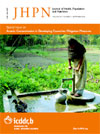
|
The Journal of Health, Population and Nutrition
icddr,b
ISSN: 1606-0997
EISSN: 1606-0997
Vol. 29, No. 5, 2011, pp. 523-531
|
 Bioline Code: hn11065
Bioline Code: hn11065
Full paper language: English
Document type: Research Article
Document available free of charge
|
|
|
The Journal of Health, Population and Nutrition, Vol. 29, No. 5, 2011, pp. 523-531
| en |
Inequalities in Care-seeking for Febrile Illness of Under-five Children in Urban Dhaka, Bangladesh
Najnin, Nusrat; Bennett, Catherine M. & Luby, Stephen P.
Abstract
Fever is an easily-recognizable primary sign for many serious childhood infections. In Bangladesh, 31% of children aged less than five years (under-five children) die from serious infections, excluding confirmed acute respiratory infections or diarrhoea. Understanding healthcare-seeking behaviour for children with fever could provide insights on how to reduce this high rate of mortality. Data from a cross-sectional survey in the catchment areas of two tertiary-level paediatric hospitals in Dhaka, Bangladesh, were analyzed to identify the factors associated with the uptake of services from trained healthcare providers for under-five children with reported febrile illness. Health and demographic data were collected in a larger study of 7,865 children using structured questionnaires. Data were selected from 1,290 of these under-five children who were taken to any healthcare provider for febrile illness within two months preceding the date of visit by the study team. Certified doctors were categorized as 'trained', and other healthcare providers were categorized as 'untrained'. Healthcare-seeking behaviours were analyzed in relation to these groups. A wealth index was constructed using principal component analysis to classify the households into socioeconomic groups. The odds ratios for factors associated with healthcare-seeking behaviours were estimated using logistic regression with adjustment for clustering. Forty-one percent of caregivers (n=529) did not seek healthcare from trained healthcare providers. Children from the highest wealth quintile were significantly more likely [odds ratio (OR)=5.6, 95% confidence interval (CI) 3.4-9.2] to be taken to trained healthcare providers compared to the poorest group. Young infants were more likely to be taken to trained healthcare providers compared to the age-group of 4-<5 years (OR=1.6, 95% CI 1.1-2.4). Male children were also more likely to be taken to trained healthcare providers (OR=1.5, 95% CI 1.2-1.9) as were children with decreased level of consciousness (OR=5.3, 95% CI 2.0-14.2). Disparities across socioeconomic groups and gender persisted in seeking quality healthcare for under-five children with febrile illness in urban Dhaka. Girls from poor families were less likely to access qualified medical care. To reduce child mortality in the short term, health education and behaviour-change communication interventions should target low-income caregivers to improve their recognition of danger-signs; reducing societal inequalities remains an important longterm goal.
Keywords
Cross-sectional studies; Fever; Gender identity; Health personnel; Patient acceptance of healthcare; Socioeconomic factors; Urban population; Bangladesh
|
| |
© Copyright 2011 Journal of Health Population and Nutrition.
Alternative site location: http://www.jhpn.net
|
|
